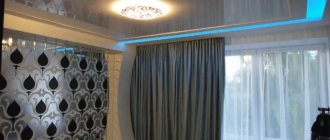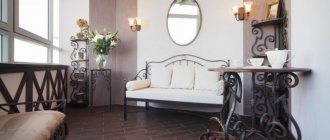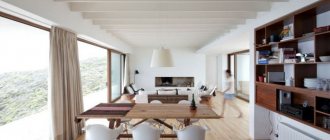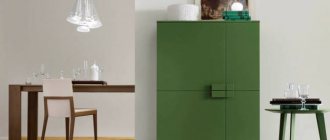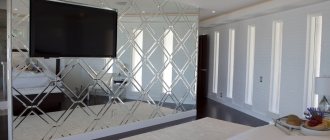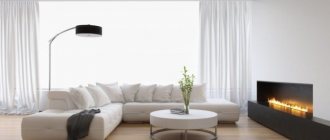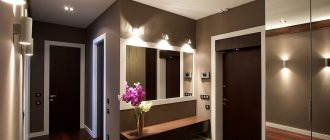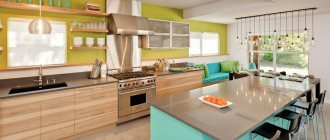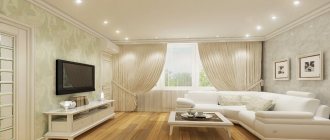Properly placed lighting can transform any room beyond recognition. Stretch ceilings themselves significantly decorate the room, and with skillfully produced lighting, they can sparkle with new facets.
Before you begin installing lamps on a suspended ceiling, it is important to carefully consider the layout of the lamps. There are a lot of nuances in this matter, and if you don’t know or ignore them, you can ruin the interior, the quality of lighting, and even increase energy consumption. Each room has its own preferred placement of lamps. In this article we will tell you how to place lamps on a suspended ceiling so that your room is beautiful, cozy and sufficiently lit, we will provide diagrams and clarify the nuances.
Basic location rules
There are certain requirements for the placement of light sources. To ensure a high-quality level of illumination, it is recommended to place products according to the following rules:
- There should be at least 20 cm from the wall to the first row of spotlights.
- The chandelier is hung strictly in the center of the ceiling.
- When the canvas is stretched, the distance from the spotlights to the seam of the PVC film should not be less than 15 cm.
- When calculating the number of lighting units, keep in mind that one spotlight can adequately illuminate 1.5-2 sq.m. It is better to take the first indicator as an ideal, but take into account the purpose of the room, because bright light is not needed everywhere.
- If you need to arrange the lamps symmetrically, it is important to ensure that they are all installed at the same distance from each other and relative to the wall.
- As for windows, you can experiment; there are no strict rules for the location of spotlights relative to the window. The main thing is that the level of illumination is sufficient.
Knowing these recommendations, you can now correctly place light sources on any ceiling, regardless of its finish. Now let’s take a closer look at the diagrams that make it most profitable to place lamps on a suspended ceiling.
Best layouts
Currently, when designing lighting, the following placement of light sources is most often used:
The most commonly used arrangement of lamps on a suspended ceiling is:
- “Oval” scheme - lighting fixtures are placed in the form of a large oval, the center of the ceiling remains empty and slightly darkened. If desired, you can install a beautiful chandelier in the center;
- circular placement - soffits are placed around the entire perimeter of the ceiling space in the form of a circle. This option allows you to illuminate the entire area as much as possible without leaving the corners of the room dark;
- corner placement - this option for placing light bulbs on a suspended ceiling must be combined with a chandelier, otherwise the illumination will be insufficient;
- in the shape of two semicircles - allows you to flood all the corners of the room with light, but you also cannot do without a chandelier;
- cross-shaped arrangement - can serve as the only source of lighting;
- “Rectangle” - perfectly visually expands the room!
- “Arc” is a beneficial move when zoning a room. The arc is placed on the suspended structure exactly where the emphasis needs to be placed by directing the lighting there;
- “Wave” - most often used for rooms of non-standard dimensions;
- Arbitrary pattern - very often a room is given an original look with the help of some pattern from the spotlights.
Advantages of spotlights
One of the main advantages of spot lighting is its versatility. With its help you can not only illuminate the entire space of the room. Such options are also used for zoning premises to highlight a work area or a recreation area. In this case, more powerful lamps are installed above a certain place in the room or, conversely, characterized by soft diffused light. Using several small light bulbs distributed throughout the ceiling area, instead of one standard chandelier, will allow you to save on electricity. It is not necessary to use incandescent lamps. Diode, halogen or fluorescent lamps consume much less electricity, but illuminate the room no worse.
Read also: DIY subwoofer assembly
Unusually wide scope for creative thought. You will find an incredible number of models that will help make your home stylish and cozy. Such lamps are practically insensitive to voltage changes. They will work even at minimum power. They can be used anywhere. These can be living rooms, hallways, kitchens, bedrooms, children's rooms, bathrooms, swimming pools and even office spaces. In any case, the ceiling will look great and the room will receive enough light.
Calculation of the number of lighting fixtures
Before you start calculating the number of light units, it is important to decide on the type of lamps that will be used. The productivity of one unit, and therefore the required number, directly depends on this. Also, to calculate the number of lamps, you will need the following information:
- room area;
- type of lamps;
- number and location of windows;
- what areas need to be emphasized;
- design and purpose of the room.
There are established standards that you should rely on when making calculations.
The easiest way to determine the number of units is to take into account a simple rule - one lamp can illuminate 1.5-2 square meters of area. So, with a room area of 20 sq. m, you will need 10 - 13 lighting fixtures, which are best placed at a distance of 25-30 cm from each other. For a symmetrical arrangement, choose an even number of spotlights; the chandelier is not taken into account in this case, but is an addition, if necessary.
Having decided on the minimum required quantity, you can already decide whether to increase it or decrease it, depending on the purpose of the room. It is still recommended not to reduce the quantity, but on the contrary, because this way the light can be made as soft and uniform as possible, without clear boundaries, unless you have a zoning goal.
Features of lighting in different rooms
Each method of arranging lighting fixtures is attractive in its own way, but is not universal, that is, it cannot be used in any room. That is why next we will look at the features of the location of light sources in different rooms: living room, hall, kitchen, bedroom, etc.
Corridor
In most apartments, the corridors are quite inconvenient, narrow and long, often L-shaped, so it is recommended to place the light here individually. For rectangular and elongated corridors, it is better to place spots along the perimeter of the ceiling, highlighting the center if necessary.
Kitchen
In the kitchen, it is best to place lamps on a suspended ceiling according to this principle: concentrate the light above the dining table, it is good if it is a chandelier, and in the work area it is good to install spotlights. The most suitable schemes in this case are 2, 5, 8 and 9 (see table). This arrangement is recommended to ensure that only the necessary parts of the kitchen are illuminated. By the way, this also allows you to save electricity, because you can always turn off the lights in the area that is not needed now.
Hall
There are a huge number of options for arranging lamps in the hall; suspended ceilings provide a wide field of activity here. The choice of lamp placement in this case is limited only by your imagination. You don’t have to install a chandelier, if the spots are arranged in a circle, this will give soft, subdued lighting. If you install a chandelier, make sure that there is a separate switch for it, so you can turn it off if desired and enjoy the soft diffused light from spotlights. This is very convenient when watching TV. Classic types of arrangement of light sources in the living room are illustrated in diagrams 4,6, 7,12. Also, for reading, it is good to place a sconce near the sofa.
Bedroom
The bedroom is a place of relaxation, so there is no need for bright lighting, which means it is quite possible to do without a chandelier. Nowadays, spot lighting, placed in a circle or oval, is increasingly used in bedroom interiors. You can also arrange the lamps in a checkerboard or zigzag pattern to add some flair to the room. Sconces near the bed are also relevant for reading.
Children's
Since the children's room is often divided into 3 zones: study, play and sleep, it is recommended to apply zoning of the room and approach the lighting individually. The brightest lighting can be achieved using spotlights above the desk, a chandelier for general lighting, and a sconce placed near the bed.
Bathroom
And finally - the bathroom. When placing lamps on a suspended ceiling, of course, you need to take into account the size and layout of the bathroom. Also note that only moisture-resistant lighting fixtures can be installed in this room. They can be placed around the perimeter of the room or in a checkerboard pattern. Placing a sconce in the area of the mirror and dressing table adds a lot of coziness to the bathroom.
That's all the basic rules that need to be followed when placing lighting. We hope our recommendations will be useful to you, will make your work much easier and will help you create skillful lighting in your home.
How to place lamps in different rooms
- Living room. The best lighting option in the living room is to place spotlights around the perimeter and hang a beautiful chandelier in the center. With this arrangement, it is possible to change the brightness of the lighting.
- Bedroom. Installing spotlights will provide diffused, pleasant, soft and unobtrusive light. Lamps in the bedroom are arranged in a rectangle, circle or oval; you can highlight the sleeping area with an arc, or install hidden lighting behind the cornices. Dimmers will help you regulate the lighting.
- Children's room. It is best to highlight play and work areas in the children's room, and install sources of diffused light in the remaining ceiling space.
- Kitchen. With the help of spotlights, you can highlight separate zones that will fill the kitchen with diffused, soft light and will not create shadows. You can place a chandelier in the center or above the table.
- Hallway. Lamps with directional spot light will help to avoid crowding and semi-darkness in the hallway.
- Bathroom. In the bathroom it is better to install spot, sealed lamps.
The correct placement of lamps, the correct selection of the number and power of lamps - this not only means the comfort of your home, but also a small amount of electricity consumed and, as a result, saving money. A thoughtful arrangement of lamps will make the interior functional, harmonious, cozy, and emphasize the uniqueness and beauty of the interior.
The new season's trend is the use of spotlights on a suspended ceiling. Such light sources are practical, easy to install and have excellent performance characteristics. Let's talk further about how to place spotlights on the ceiling to get the most attractive interior.
Brief essence
- Beautiful lighting is an integral part of a modern interior.
- When starting to carry out lighting, it is important to take into account many nuances - the area of the room, the type of lamps and their number, the design and purpose of the room.
- There are many layouts of lamps on a suspended ceiling, depending on the area and purpose of the room.
- Each room can be emphasized with skillful lighting. In the living room it is better to combine a chandelier and spotlights, in the bedroom you can get by with only spotlights and sconces, in the nursery it is good to combine a chandelier, sconces and spotlights. In short, any room can be decorated in an original way with the help of beautiful lighting.
Stretch ceiling with light bulbs in a circle and other options.
SocButtons v1.6
Few modern decor can do without new spotlights. They save space and have a large number of appearance options. In combination with tension fabrics, spots are placed on the surface in different ways. This is a suspended ceiling with light bulbs in a circle, and in the form of a line or spiral. The choice of option depends on the style of the room, the presence of other lighting fixtures, the designer’s ideas, etc.
How much do you need spotlights?
The decision to use small lighting fixtures on the ceiling should be a smart one. You should carefully consider the choice of light source. Let us remind you that there are LED, halogen, and energy-saving spots. It is best to use the first and last types in combination with tension film sheets. They do not heat up the space around them, serve for a long time and do not need to be replaced or repaired.
Again, it is important to consider the number of light bulbs. To what extent will they be justified in one case or another? Usually they make one or two devices per square meter. The optimal distance between them is about thirty centimeters.
It is worth considering the purpose of the room and its zoning. For example, in some cases it will be more appropriate to make spots above a certain area of the room to give it more brightness, rather than across the entire surface. In combination with a chandelier, fewer spots need to be used. But their location will be different. This is where suspended ceiling options with light bulbs in a circle or in the form of an oval will show themselves perfectly.
Main location options
- In the corners. With a small area, the options for spots in the corners of the room look good. They highlight only certain parts of the space. This approach also makes it possible to create more or less uniform, but slightly dimmed light throughout the room.
- Stretch ceiling with light bulbs all around. In this case, the central part will be illuminated as much as possible, while the corner elements will be illuminated less. This option is suitable both on its own and in combination with a chandelier, as mentioned above. Such geometric approaches look gentle and versatile. They show themselves perfectly both in the center of the room on a single-level structure, and on its sides in the case of installing two or more levels.
- Spirals and waves. Light bulbs that are installed in the form of waves or beautiful spirals look stylish and more original. Typically, such options are used without a chandelier. They will add creativity to the room. Spirals show themselves beautifully in the living room or bedroom. They can be combined with bright and rich tones of the material, while still providing enough illumination.
- Lines along the walls. In small spaces or in the case of calm and restrained decors, use line-shaped spots. They are located near one or several walls, can highlight the first or second level, or emphasize a certain area.
Expert advice
You should not choose light bulbs only with the goal of making the interior richer or stuffing it with various equipment. In fact, spots should be in demand and fulfill their immediate functions.- Consider the power of the lamps and the coating material. Incandescent lamps should not exceed 40 W for film panels and 60 W for fabric panels. But halogen ones - 30 W when installing PVC coverings.
- If there is a chandelier in the room, then you should step back at least fifteen centimeters from it when installing devices.
- To make the lighting more functional, it is better to install rotary devices. They will direct light to those places where it is really needed.
- Choose the tone of the light carefully. It may be yellowish and white. If you want to create a gentle and comfortable decor, then it is better to use yellow options (in the living room, bedroom). But white ones will give more light and help emphasize modernity. They are usually used in the kitchen, bathroom, hallway.
Let's sum it up
There are a lot of options for the location of spotlights. They are used both in a circle and in the form of a line or waves. When choosing, it is important to rely not only on the appearance of the lamp, but also on its functionality, and take into account the degree of compatibility with stretch fabrics and the decor of the room.
We recommend reading:
Stretch ceilings in the bedroom
Safety of suspended ceilings and impact on human health.
Stretch ceilings in the apartment and different design styles
Stretch ceilings: differences and types
Seven mistakes when choosing a stretch ceiling
